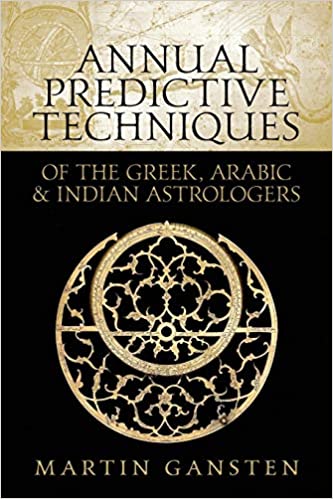This scholarly book has a singular focus on forecasting methods. Gansten has collated material from ancient Hellenic (Greek) and Hindu as well as medieval Persian sources. His many years of experimentation with these methods gives the reader the benefit of earned wisdom.
The introduction explains the author’s approach. Part I focuses on the time line of ancient-to-medieval astrological traditions and transmission, and provides the terminology that will be used in the book. Readers should be aware that the author uses the seven visible planets and the sidereal zodiac; however, these methods can also be used with the tropical zodiac.
Gansten covers the earliest extant sources on these methods and explains his reasons for using the sidereal zodiac. The Indian astrological branch called Tajika shares similarities with the Greek and later medieval Persian methods; information from this school is merged into the methodology. The importance of the solar return’s Ascendant ruler (a chronocrater or time lord) is discussed here with a list of considerations for judgment (interpretive rules). The importance and function of annual profections and the Lord of the Year is also considered.
Part 2, Chapter 6 opens with a technique called Primary Directions, an early form of progression. The natal Ascendant is moved forward to ascertain the current bound (term) ruler, which Gansten calls the “divisor,” and its planetary partner, the “primissor.” (Ben Dykes refers to these as the distributor and partner). These planets are grouped with other time lords for prognostication shown in sample chart demonstrations.
Chapter 8 “Judging the Revolution Figure” is the longest and most important section of the book as it “attempts to set out an integrated method of judging the overall results of any year of life.” Numerous chart examples demonstrate the full range of annual predictive techniques. Chapter 9 follows up with techniques for discovering for eventful times during a given year by comparing transits and planetary stations to the natal and solar return charts. The methods are surprisingly effective once the rules are understood. Back matter includes four helpful appendices, a glossary, bibliography, and an index.
This book is particularly recommended for traditional and medieval-style astrologers who want to sharpen their predictive skills using methods from those periods with proven efficiency. It provides succinct and well-written instructions and effective demonstrations with printed chart illustrations. Ben Dyke’s book “Persian Nativities III: Solar Revolutions” is an excellent entry into these methods; Gansten’s “Annual Predictive Techniques” merger of Hellenic, Persian and Hindu source material with ample demonstrations is an excellent follow-up text that expands on the methodology in useful ways.
Author: Martin Gansten
2020, The Wessex Astrologer
260 pages. $21.00 pb, $9.99 Kindle

